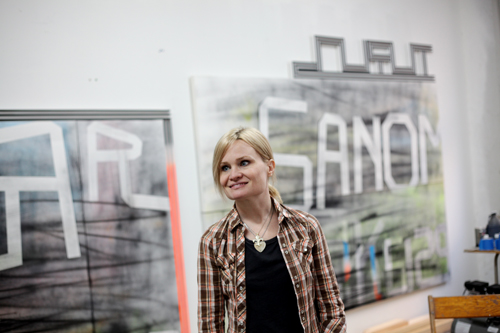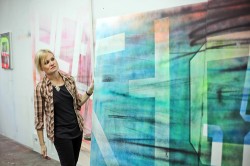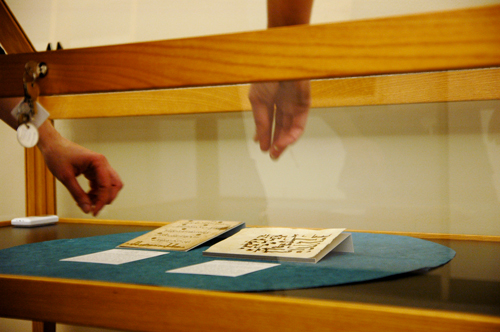Wendy White’s approach to painting is unique and eclectic. For her, the materials she uses to paint with are as important as the paintings themselves.
The architecture of visual art

Wendy White’s approach to painting is unique and eclectic. For her, the materials she uses to paint with are as important as the paintings themselves.
In her MFA Studio Lecture, taking place tomorrow in PSU’s Shattuck Hall Annex, White will discuss her most recent pieces and provide insight into her own creative process. She will also cover how her creations differ, both literally and metaphorically, from more traditional methods of visual art—one of humanity’s most popular outlets for emotion, storytelling and social commentary.
“Historically, painting—all art, basically—has been about illusion, about putting something on the canvas and getting it out there. There is much emphasis on scale of depiction, on how well you can imitate what you are painting,” White said. “For me, it’s not just an image I’m making; it’s how I’m making it.”
Among the pieces discussed in White’s event will be “Three Stripes,” a satire on the famous Adidas symbol made of three-dimensional wooden frames. The painting reminds one of elegant graffiti, with spray-painted words and letters in various colors and three thick lines running boldly down it in a manner of electric power cables.
White said that “Three Stripes,” along with her other recent works, demonstrates her dedication to the process of creation.
“I want my art to become part of the architecture, to actually be architecture in itself. It’s all about working with the space I am given, molding and shaping it until it is an integral part of the artwork,” she said. “Hopefully, students who come to the lecture will come away with a perception of how I do this.”
Architecture plays a cardinal role in White’s art. Not content with the traditional artist’s solitary canvas and brush, she uses her base material as yet another color in her artistic pallette rather than as a jumping-off point. This style has not always been revered by the academic art community, which still adheres to the classic painting forms, according to White.
“In no way am I an anti-intellectual. I got my master’s degree in fine arts and am very connected with artistic academia,” White said. “However, that certain scholarly community is a very serious group of people with a very specific way of speaking, and I would like to demystify that language so it is more accessible.”
White worked largely with sculpture until 2001 when she received her MFA. Since then, her paintings have gained increasing media attention. Her work has been featured in Art in America and New York Sun magazines and has taken her to Germany, Hungary and all across the United States. She has also had dozens of solo exhibitions, mostly in her hometown of New York City.
“I have always been a creative person, but until my time in graduate school I was painting with different things and using different styles. I didn’t paint furiously and in the way I do now until about six years ago,” she said. “I became a painter trained in fibers—canvas—and from there I started working with ways that I could use canvas as art in itself.”
As is true for so many artists, White’s inspiration comes from her personal life. But functionalist-style Scandinavian architecture and her urban Chinatown neighborhood also number among her muses.
“Once I’m inspired, I have to manifest it and transform what’s in my head into something that others can experience for themselves,” White said. “If I feel like it has to lean towards you—stand on its own or seem far away—I make it do that.”
Sometimes, in order to create something truly original, you have to be willing to break the rules, White said, and she uses this rule of rule-breaking to her advantage.
“I am a free artist. I allow myself to be changed by my art,” White said. “Being multi-dimensional and open is how I am able to do what I do, and bringing people into my world through art is part of that.”







